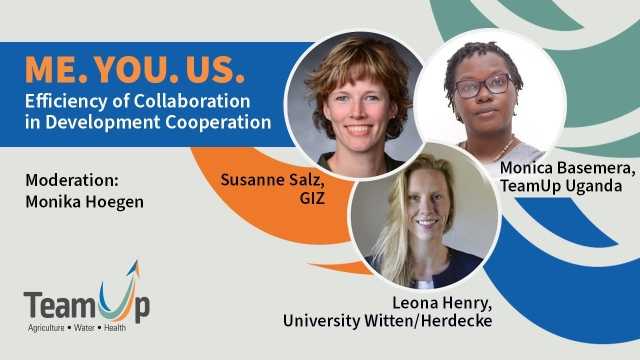MITYANA (Uganda) – The multi-stakeholder partnership TeamUp Uganda outlined during an expert panel discussion how collaborative approaches in development cooperation can be successful. Susanne Salz (GIZ), Leona Henry (University Witten/Herdecke), and Monica Basemera (TeamUp Uganda) agreed that this can only be achieved with localized structures, proper planning, a joint vision, and clear governance and communication lines.
TeamUp Uganda in the panel discussion “Me. You. Us. Efficiency of Collaboration in Development Cooperation”
TeamUp Uganda is such a multi-stakeholder partnership. Starting in 2019 in Mityana District close to the Ugandan capital Kampala in the areas of agriculture, water, and health, it combines the expertises of three implementing organisations in Uganda: Action 4 Health Uganda, Hanns R. Neumann Stiftung, and Whave Solutions. By the end of the pilot phase in 2022, the group had collected a bucket full of experience about how to set up and implement a multi-stakeholder partnership.
The panel discussion “Me. You. Us. Efficiency of Collaboration in Development Cooperation” identified four key areas that need to be acknowledged for a successful multi-stakeholder approach:
1. It takes time, commitment, and work to develop successful partnerships
“When we started out we had to set the parameters very clearly”, Basemera emphasized. The specifics of each and every partner had to be taken into account as well as the intersections of the different areas of work.” However, the organizational structure of the partnership is also critical. “The democratic processes within the partnership are of utmost importance”, Leona Henry stressed. “Good intentions and high ambitions are no guarantee for success.” Susanne Salz added that a Theory of Change is needed and that it is only possible to measure successes and failures if there has been proper stocktaking.
Multi-stakeholder partnerships can be more successful and sustainable if they make use of the arrangements and structures that already exist in communities. However, if those cannot be found, the stakeholders have to build them and make sure that they are controlled by young people who should also make the decisions, Basemera recommended.
2. Multi-stakeholder partnerships often struggle to maximize their impact on the field level
The messages coming in from monitoring and evaluation are usually not such a good fit for partnerships. “An impact narrative is better suited to inform partners, members, and the public – especially at the beginning of a project phase”, Salz suggested. Monica Basemera explained how a joint office fosters efficiency, cost-effectiveness, and synergy effects: “You can talk to each other directly and if you are going to the field or if you are visiting the district you can go together. If you are doing a workshop you don’t have to do it two or three times over”, she concretized her experience from Team Up.
“A truly bottom-up approach is crucial. Involving a multitude of people creates efficiency problems. It is a conflict of objectives”, Henry weighed in. The resulting collaborative challenges tend to return repeatedly throughout a project cycle and demand a strong coordinative person or even unit to manage them.
3. How to deal with possible disruptions
During her research, Leona Henry discovered that a multi-stakeholder cooperation can be very resilient in times of crisis if it manages to develop innovative and entrepreneurial approaches to community engagement very quickly – and jointly with community members. This can be achieved for example by mobilizing digital technology in new ways or by restructuring the setup in a novel manner. “After overcoming an obstacle the partnership can even bounce back stronger”, Henry summarized her findings. For her, TeamUp Uganda managed well during the COVID-19 pandemic, for example, which has been part of her research.
4. Multi-stakeholder approaches do not function without respect and fairness
Susanne Salz listed the most important preconditions for respect and fairness between diverse actors: “Having common goals, having trust, having transparency, having communication and governance structures in place – all of that definitely matters. Communication, clear communication channels and trust are important keys in achieving role clarity.”
Monica Basemera concluded: “Every stakeholder and partner needs a certain degree of autonomy to fulfill the tasks at hand. If you learn from mistakes, it’s ok. You have to accept and sometimes even allow them.” However, in her concluding remarks, she remembered everybody, that a multi-stakeholder cooperation remains a mere means to an end: “Our goal is to make ourselves not needed.”
The panel discussion “Me. You. Us. Efficiency in Development Cooperation” can be viewed on the YouTube channel of TeamUp:
About TeamUp Uganda
TeamUp creates opportunities for youth in rural Uganda. It helps youth lead a healthy and self-determined life and take advantage of opportunities for jobs, entrepreneurship and participation in public and political life. Especially in the areas of health, agribusiness and water, sanitation, and hygiene (WASH).
TeamUp is a unique cooperation between the Deutsche Stiftung Weltbevölkerung (DSW), Hanns R. Neumann Stiftung (HRNS) and Siemens Stiftung and the German Federal Ministry for Economic Cooperation and Development (BMZ) that brings together expertise, networks and resources of each of the partners.
TeamUp aims to prove that multi-sectoral synergies created through the collaboration of various partners can lead to a high positive social impact. The program is implemented by the Ugandan NGO’s Action for Health Uganda (A4HU), Whave Solutions and Hanns R. Neumann Stiftung Africa.


















